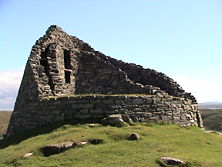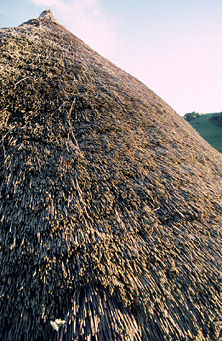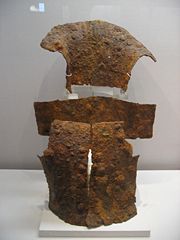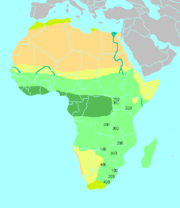Iron Age
2008/9 Schools Wikipedia Selection. Related subjects: Ancient History, Classical History and Mythology; British History 1500 and before (including Roman Britain)
| Iron Age |
|---|
| ↑ Bronze Age |
|
Bronze Age collapse Ancient Near East (1300-600 BC)
India (1200-200 BC)
Europe (1000 BC-400 AD) China (600-200 BC)
Japan (500 BC-300 AD)
Korea (400-60 BC) Nigeria (400 BC-200 AD) |
|
Axial Age |
↓ Historiography
|
In archaeology, the Iron Age was the stage in the development of any people in which tools and weapons whose main ingredient was iron were prominent. The adoption of this material coincided with other changes in some past societies often including differing agricultural practices, religious beliefs and artistic styles, although this was not always the case.
In history, the Iron Age is the last principal period in the three-age system for classifying pre-historic societies, preceded by the Bronze Age. Its date and context vary depending on the country or geographical region.
No firm ending date is set for the Iron Age in any particular society; there is simply a point where archaeology becomes less important than surviving history and traditions. Iron alloys remain popular as the steels in most metallic objects.
Dates

Classically, the Iron Age is taken to begin in the 12th century BC in the ancient Near East, ancient Persia, ancient India (with the post-Rigvedic Vedic civilization), and ancient Greece (with the Greek Dark Ages). In other regions of Europe, it started much later. The Iron Age began in the 8th century BC in Central Europe and the 6th century BC in Northern Europe. Iron use, in smelting and forging for tools, appears in West Africa by 1200 BC, making it one of the first places for the birth of the Iron Age.
The Iron Age is divided into two subsections, Iron I and Iron II. Iron I (1200-1000) illustrates both continuity and discontinuity with the previous Late Bronze Age. There is no definitive cultural break between the thirteenth and twelfth century throughout the entire region, although certain new features in the hill country, Transjordan and coastal region may suggest the appearance of the Aramaean and Sea People groups. There is evidence, however, that shows strong continuity with Bronze Age culture, although as one moves later into Iron I the culture begins to diverge more significantly from that of the late second millennium.
The Iron Age is usually said to end in the Mediterranean with the onset of historical tradition during Hellenism and the Roman Empire, in India with the onset of Buddhism and Jainism, in China with the onset of Confucianism, and in Northern Europe with the early Middle Ages.
The arrival of iron use in various areas is discussed in more detail below, broadly in chronological order.
Iron use in the Bronze Age
By the Middle Bronze Age, increasing numbers of smelted iron objects (distinguishable from meteoric iron by the lack of nickel in the product) appeared throughout Anatolia, Mesopotamia, the Indian subcontinent, the Levant, the Mediterranean, and Egypt. In some places, their use appears to have been ceremonial, and during the Bronze Age iron was an expensive metal, more expensive than gold. Some sources suggest that iron was being created in some places then as a by-product of copper refining, as sponge iron, and was not reproducible by the metallurgy of the time.
The earliest systematic production and use of iron implements originates in Anatolia. West African production of iron began at around the same time, and seems to have been clearly an independent invention (see Stanley J. Alpern's work in History in Africa, volume 2). Recent archaeological research at Ganges Valley, India showed early iron working by 1800 BC. By 1200 BC, iron was widely used in the Middle East but did not supplant the dominant use of bronze for some time.
Transition from bronze to iron
Bronze was previously used to make tools because its melting point is lower than that of iron. The Iron Age began with the development of higher temperature smelting techniques..
During the Iron Age, the best tools and weapons were made from steel, an alloy consisting of iron with a carbon content between 0.02% and 1.7% by weight. Steel weapons and tools were nearly the same weight as those of bronze, but stronger. However, steel was difficult to produce with the methods available. Therefore, many Iron Age tools were fashioned of wrought iron. Wrought iron is weaker than bronze, but because it was less expensive, and more easily sharpened, people used it anyway. Iron is by itself an adequately strong metal without additional alloys (although it could be further strengthened by case-hardening or forge welding small amounts of steel to areas subject to wear such as edges). Bronze, on the other hand, requires copper and tin which are less common than iron. Additionally, iron can be sharpened by grinding whereas bronze must be reforged.
Around 1800 BC, for reasons yet unknown to archaeologists, tin became scarce in the Levant, causing a decline in bronze production. Copper, also, came to be in short supply. As a result, pirate groups around the Mediterranean, from around 1800-1700 BC onward, began to attack fortified cities in search of bronze, to remelt into weaponry.
Bronze was much more abundant in the period before the 12th to 10th century and Snodgrass suggests that a shortage of tin, as a result of the trade disruptions in the Mediterranean at this time, forced peoples to seek an alternative to bronze. That many bronze items were recycled and made from implements into weapons during this time, is evidence of this.
Ancient Near East
Transition
The Iron Age in the Ancient Near East is believed to have begun with the discovery of iron smelting and smithing techniques in Anatolia or the Caucasus in the late 2nd millennium BC (circa 1300 BC).
The use of iron weapons instead of bronze weapons spread rapidly throughout the Near East by the beginning of the 1st millennium BC. Anatolians had begun forging weapons out of iron, which was a superior metal to bronze by 1500 BC at the latest.
The use of iron weapons by the Hittites was believed to have been a major factor in the rapid rise of the Hittite Empire. Because the area in which iron technology first developed was near the Aegean, the technology expanded into into both Asia and Europe simultaneously, aided by Hittite expansion. The Sea Peoples and the related Philistines are often associated with the introduction of iron technology into Asia, as are the Dorians with respect to Greece.
Finds of Iron Early examples and distribution of non precious metal finds.
| Date | Crete | Aegean | Greece | Cyprus | Total | Anatolia | Grand total |
|---|---|---|---|---|---|---|---|
| 1300-1200 BC | 5 | 2 | 9 | 0 | 16 | 33 | 65 |
| 1200-1100 BC | 1 | 2 | 8 | 26 | 37 | N.A. | 74 |
| 1100-1000 BC | 13 | 3 | 31 | 33 | 80 | N.A. | 160 |
| 1000-900 BC | 37 | 30 | 115 | 29 | 1.40 | N.A. | 211 |
| Total Bronze Age | 5 | 2 | 9 | 0 | 16 | 33 | 65 |
| Total Iron Age | 51 | 35 | 163 | 88 | 337 | N.A. | 511 |
Assyria
Levant
Anatolia
Aegean
Egypt
Indian subcontinent
Archaeological sites in India, such as Malhar, Dadupur, Raja Nala Ka Tila and Lahuradewa in present day Uttar Pradesh show iron implements in the period between 1800 BC - 1200 BC. Some scholars believe that by the early 13th century BC, iron smelting was practiced on a bigger scale in India, suggesting that the date the technology's inception may be placed earlier.
The beginning of the 1st millennium BC saw extensive developments in iron metallurgy in India. Technological advancement and mastery of iron metallurgy was achieved during this period of peaceful settlements. An iron working centre in east India has been dated to the first millennium BC.
In Southern India (present day Mysore) iron appeared as early as 11th to 12th centuries BC; these developments were too early for any significant close contact with the northwest of the country.
The Indian Upnishads have mentions of weaving, pottery, and metallurgy.
The Mauryan period in India saw advancements in technology; this technological change involved metallurgy.
Perhaps as early as 300 BC, although certainly by AD 200, high quality steel was being produced in southern India also by what Europeans would later call the crucible technique. In this system, high-purity wrought iron, charcoal, and glass were mixed in crucible and heated until the iron melted and absorbed the carbon.
East Asia
China
In 1972, near the city of Gaocheng (藁城) in Shijiazhuang (now Hebei province), an iron-bladed bronze tomahawk (铁刃青铜钺) dating back to the 14th century BC was excavated. After a scientific examination, the iron was shown to be made from meteoric siderite. The Iron Age in East Asia began in earnest, however, when cast-iron objects appeared in Yangzi Valley toward the end of the 6th century BC. The few objects were found at Changsha and Nanjing. According to the mortuary evidence suggests that the initial use of iron in Lingnan belongs to the mid to late Warring States period (from about 350 BC).
The techniques used in Lingnan is a combination of bivalve moulds of distinct southern tradition and the incorporation of piece mould technology from the Zhongyuan The products of the combination of these two periods are bells, vessels, weapons and ornaments and the sophisticated cast.
An Iron Age culture of the Tibetan Plateau has tentatively been associated with the Zhang Zhung culture described in early Tibetan writings.
Japan
The Yayoi period (弥生時代 Yayoi-jidai ?) is an era in the history of Japan from about 500 BC to 300 AD. Distinguishing characteristics of the Yayoi period include the appearance of new pottery styles and the start of an intensive rice agriculture in paddy fields. The Yayoi followed the Jōmon period (14,000 BC to 500 BC) and Yayoi culture flourished in a geographic area from southern Kyūshū to northern Honshū.
The succeeding Kofun period (古墳時代 Kofun-jidai ?) lasts from around 250 to 538. The word kofun is Japanese for the type of burial mounds dating from this era. The Kofun and the subsequent Asuka periods are sometimes referred to collectively as the Yamato period.
Korea
Iron objects were introduced to the Korean peninsula through trade with chiefdoms and state-level societies in the Yellow Sea area in the fourth century BC, just at the end of the Warring States Period but before the Western Han Dynasty began. Yoon proposes that iron was first introduced to chiefdoms located along North Korean river valleys that flow into the Yellow Sea such as the Cheongcheon and Taedong Rivers. Iron production quickly followed in the 2nd century BC, and iron implements came to be used by farmers by the 1st century AD in southern Korea. The earliest known cast-iron axes in southern Korea are found in the Geum River basin. The time that iron production begins is the same time that complex chiefdoms of Proto-historic Korea emerged. The complex chiefdoms were the precursors of early states such as Silla, Baekje, Goguryeo, and Gaya Iron ingots were an important mortuary item and indicated the wealth or prestige of the deceased in this period.
Europe
Iron working was introduced to Europe around 1000 BC, probably from Asia Minor and slowly spread northwards and westwards over the succeeding 500 years.
Eastern Europe
The early 1st millennium BC marks the Iron Age in Eastern Europe. In the Pontic steppe and the Caucasus region, the Iron Age begins with the Koban and the Chernogorovka and Novocherkassk cultures from ca. 900 BC. By 800 BC, it was spreading to Hallstatt C via the alleged " Thraco-Cimmerian" migrations.
Along with Chernogorovka and Novocherkassk cultures, on the territory of ancient Russia and Ukraine the Iron Age is to a significant extent associated with Scythians, who developed iron culture since the 7th century BC. The majority of remains of their iron producing and blacksmith's industries from 5th to 3rd century BC was found near Nikopol in Kamenskoe Gorodishche, which is believed to be the specialized metallurgic region of the ancient Scythia.
From the Hallstatt culture, the Iron Age spreads west with the Celtic expansion from the 6th century BC. In Poland, the Iron Age reaches the late Lusatian culture in about the 6th century, followed in some areas by the Pomeranian culture.
The ethnic ascriptions of many Iron Age cultures has been bitterly contested, as the roots of Germanic, Baltic and Slavic peoples were sought in this area.
Central Europe
In Central Europe, the Iron Age is generally divided in the early Iron Age Hallstatt culture (HaC and D, 800- 450) and the late Iron Age La Tène culture (beginning in 450 BC). The Iron Age ends with the Roman Conquest.
Italy
In Italy, the Iron Age was probably introduced by the Villanovan culture but this culture is otherwise considered a Bronze Age culture, while the following Etruscan civilization is regarded as part of Iron Age proper. The Etruscan Iron Age was then ended with the rise and conquest of the Roman Republic, which conquered the last Etruscan city of Velzna in 265 BC.
British Isles
In the British Isles, the Iron Age lasted from about 800 BC until the Roman conquest and until the 5th century AD in non-Romanised parts. Structures dating from this time are often impressive, for example the brochs and duns of northern Scotland and the hill forts that dotted the islands.
Northern Europe
The Iron Age is divided into the Pre-Roman Iron Age and the Roman Iron Age. This is followed by the migration period. Northern Germany and Denmark was dominated by the Jastorf culture, whereas the culture of the southern half of the Scandinavia was dominated by the very similar Gregan Iron Age.
Early Scandinavian iron production typically involved the harvesting of bog iron. Scandinavian peninsula, Finland and Estonia show sophisticated iron production very early, but further dating is currently impossible. The range varies from 3000 BP - 2000 BP. This knowledge is associated with the non-Germanic part of Scandinavia. Metalworking and Asbestos-Ceramic pottery are somewhat synonymous in Scandinavia due to the latter's capacity to resist and retain heat. The iron ore used is believed to have been iron sand (such as red soil), because its high phosphorus content can be identified in slag. They are sometimes found together with asbestos ware axes belonging to the Ananjino Culture. The Asbestos-Ceramic ware remains a mystery, because there are other adiabatic vessels with unknown usage.
Sub-Saharan Africa
Inhabitants at Termit, in eastern Niger became the first iron smelting people in West Africa and among the first in the world around 1500 BC, according to "a formidable new scientific work from UNESCO Publishing that challenges a lot of conventional thinking on the subject.". Iron and copper working then continued to spread southward through the continent, reaching the Cape around AD 200. The widespread use of iron revolutionized the Bantu-speaking farming communities who adopted it, driving out and absorbing the rock tool using hunter-gatherer societies they encountered as they expanded to farm wider areas of savannah. The technologically superior Bantu-speakers spread across southern Africa and became wealthy and powerful, producing iron for tools and weapons in large, industrial quantities.


